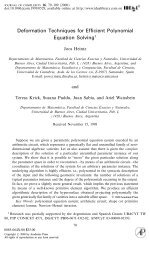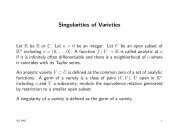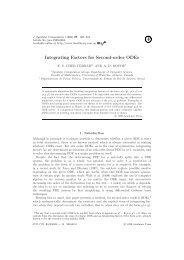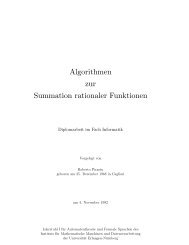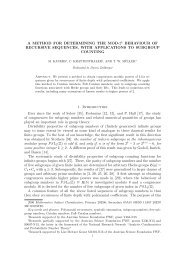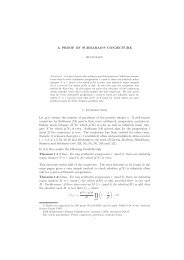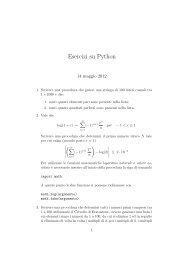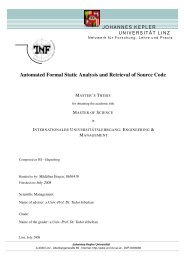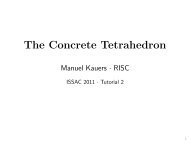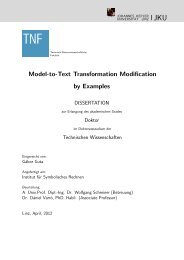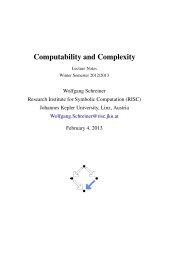Chapter 7 Local properties of plane algebraic curves - RISC
Chapter 7 Local properties of plane algebraic curves - RISC
Chapter 7 Local properties of plane algebraic curves - RISC
Create successful ePaper yourself
Turn your PDF publications into a flip-book with our unique Google optimized e-Paper software.
(3) If T is a linear change <strong>of</strong> coordinates, and C ′ , D ′ , P ′ are the imagines <strong>of</strong> C, D,<br />
and P under T, respectively, then mult P (C, D) = mult P ′(C ′ , D ′ ).<br />
(4) mult P (C, D) = mult P (D, C).<br />
(5) mult P (C, D) ≥ mult P (C) · mult P (D). Furthermore, equality holds if and only C<br />
and D intersect transversally at P (i.e. if the <strong>curves</strong> have no common tangents<br />
at P).<br />
(6) Let C 1 , . . .,C r and D 1 , . . .,D s be the irreducible components <strong>of</strong> C and D respectively.<br />
Then<br />
r∑ s∑<br />
mult P (C, D) = mult P (C i , D j ).<br />
i=1<br />
(7) mult P (C, D) = mult P (C, D H ), where D H is the curve defined by G + HF for an<br />
arbitrary form H ∈ K[x, y, z] (i.e. the intersection multiplicity does not depend<br />
on the particular representative G in the coordinate ring <strong>of</strong> C).<br />
Pro<strong>of</strong>: We have already remarked above that the intersection multiplicity is independent<br />
<strong>of</strong> a particular linear change <strong>of</strong> coordinates. Statements (1),(2),and (4) can be<br />
easily deduced from the definition <strong>of</strong> multiplicity <strong>of</strong> intersection, and we leave them to<br />
the reader.<br />
A pro<strong>of</strong> <strong>of</strong> (5) can be found for instance in [Wal50], Chap. IV.5, Theorem 5.10.<br />
(6) Let us assume without loss <strong>of</strong> generality that C and D satisfy the requirements <strong>of</strong><br />
Definition 7.2.1. That is, (0 : 0 : 1) is not on the <strong>curves</strong> nor on any line connecting<br />
their intersection points. Let F i , i = 1, . . ., r, and G j , j = 1 . . .,s, be the defining polynomials<br />
<strong>of</strong> C i and D j , respectively. Then we use the following fact: if A, B, C ∈ D[x],<br />
where D is an integral domain, then res x (A, B · C) = res x (A, B) · res x (A, C) (see, for<br />
instance, [BCL83] Theorem 3 p. 178). Hence, (6) follows immediately from<br />
j=1<br />
r∏ s∏<br />
res z ( F i , G j ) =<br />
i=1 j=1<br />
r∏ s∏<br />
res z (F i , G j ) =<br />
i=1 j=1<br />
r∏ s∏<br />
res z (F i , G j ).<br />
i=1 j=1<br />
(7) Let H ∈ K[x, y, z] be a form. Obviously P ∈ C ∩ D if and only if P ∈ C ∩<br />
D H . We assume without loss <strong>of</strong> generality that C and D satisfy the conditions <strong>of</strong> the<br />
Definition 7.2.1, and also C and D H satisfy these conditions. Then, mult P (C, D) and<br />
mult P (C, D H ) are given by the multiplicities <strong>of</strong> the corresponding factors in res z (F, G)<br />
and res z (F, G + H F), respectively. Now, we use the following property <strong>of</strong> resultants:<br />
if A, B, C ∈ D[x], where D is an integral domain, and a is the leading coefficient <strong>of</strong><br />
A, then res x (A, B) = a deg x (B)−deg x (A C+B) res x (A, A C + B) (see, for instance, [BCL83]<br />
Theorem 4, p. 178). (7) follows directly from this fact, since the leading coefficient <strong>of</strong><br />
F in z is a non-zero constant (note that (0 : 0 : 1) is not on C).<br />
100



